Yakiniku Nigiri
Meat (beef) from the process of Yakiniku(Grill) is used in Nigiri style sushi. Beef is marinated in sukiyaki, finely chopped green paprika, and topped with hints of finely chopped onion. Read more on Yakiniku.
Meat (beef) from the process of Yakiniku(Grill) is used in Nigiri style sushi. Beef is marinated in sukiyaki, finely chopped green paprika, and topped with hints of finely chopped onion. Read more on Yakiniku.
Yakiniku is a popular Japanese dish that originated from Korea. It is a special kind of barbecue whereby small pieces of meat and vegetables are cooked on a table grill. In addition, most homes and restaurants throughout Japan use different sauces for the dish.
Norse Hutchens an expert in home-brewing has developed many home kits from Wine to Moonshine. We are excited to say that also available is a Sake Making Kit!
"Traditional Japanese sake production can be complicated and exacting, but this kit makes it easy with everything you'll need (except 1 lb. of white raisins and 2.5 lbs. of sugar) to brew multiple one gallon batches of your own sake in a hands-on exploration of ancient art and science."
Inari sushi is a type of rice ball that is very popular in Japanese culture. It is sushi rice stuffed in seasoned Aburaage tofu pouches that closely resemble most of the sushi delicacies served in Japanese restaurants.
It is also available in various supermarket delis. However, most people agree that homemade sushi is the best. Inari sushi is considered to be a very casual food and perfect for picnic lunches because it can be eaten right from your hands.
Aburaage is type of tofu that is deep fried and used in various Japanese cuisines. Its texture is slightly spongy and this makes it desirable to most people. Because it’s deep fried, Aburaage can be pretty greasy. As a result, it is usually boiled in hot water before it’s prepared. For Inari sushi cuisines, Aburaage is cooked using a very sweet seasoning. This unique taste compliments the sushi rice very well. When cooking, you should leave the Aburaage to soak in sweet source for some time so that it absorbs as much flavor as it can. In addition, do not squeeze out too much sauce because that is the liquid flavor.
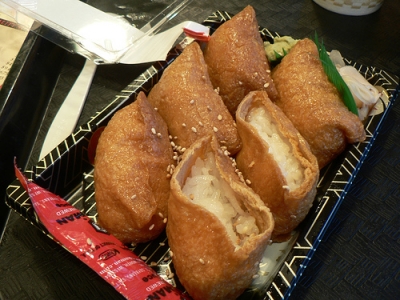
![]() by stu_spivack Inari Sushi Take-out
by stu_spivack Inari Sushi Take-out
You can also use ordinary white rice to fill the Aburaage, but to make it tastier; you should add some cooked vegetables. This is because the vegetables provide that extra flavor needed and also make the dish appear more appetizing. Some of the vegetables you can use include carrots, dried mushrooms, bamboo shoots or Hijiki sea weed. It all depends on what you like.
There is a wide range of different ingredients that can be used to prepare diverse flavors of Inari sushi. You can try out vegetables such as Gobo Japanese burdock, daikon Japanese radish or even season the rice with furikake.
The following is a list of the most essential ingredients used in making Inari sushi:
In addition, you should always remember to keep your hands wet when mixing the rice and stuffing into the Aburaage tofu pouches. Japanese rice is usually very sticky. Keeping your hands wet will prevent you from making a mess of things.
If you don’t like raw fish, then you should definitely try Inari sushi. For those who like regular sushi, you will still have a taste for the dish. Even though Inari sushi is mainly consumed in Japan, it is gradually being accepted in western cultures.
C.B. Cebulski from Eataku recently visited a Sake bar in Miniato-ku Tokyo, called Ukyo. He was in for quite a "Foodie Adventure." Check out some of the amazing Sake/Food pairings he was served. We warn you, you may salivate.
As we had all just eaten, we pretty much just drank from Ukyo’s vast list of top-notch sakes, which features over 200 bottles from around Japan, personally curated by the owner, Okada-san…
A pop-up “My Melody Cafe” opened in Shibuya Parco’s “THE GUEST cafe & diner” last July 18th, and will be open until August 31st, following the success of the pop-up “Kiki and Lala Cafe” where customers had to wait in line for 3 hours just to get in.
With an original menu, the cafe offers My Melody-inspired decor and a photo booth with My Melody hair accessories that allow you to “transform” into My Melody. The cafe also has a gift shop with products exclusive to the cafe.
Kewpie is not a style of mayo, but rather a brand. It was introduced back in 1925 in Japan. Since then, its popularity has significantly grown. It symbolizes the best of Japanese mayo, just like the original Kewpie doll is was based on.
Kewpie’s origins can be traced back to the years following World War 1, when Toichiro Nakashima founded the Nakishamato Corporation in 1918. Toichiro served as an intern at Japan’s Department of Agriculture and Commerce. He was sent to the United States and Europe to study food production techniques. After his return to Japan, Toichiro decided to implement the production, canning and marketing techniques that he had learned abroad. In 1919, Toichiro started a food production company called Shokuhin Kogyo Co.
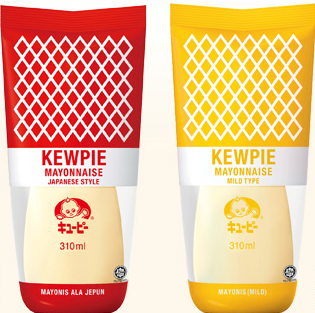
The company produced traditional Japanese food products, including various canned tangerines. In the early 1920s, Toichiro decided to visit the United States once more. He managed to return to Japan with a box of mayonnaise. During that period, most Japanese people were not familiar with the product.
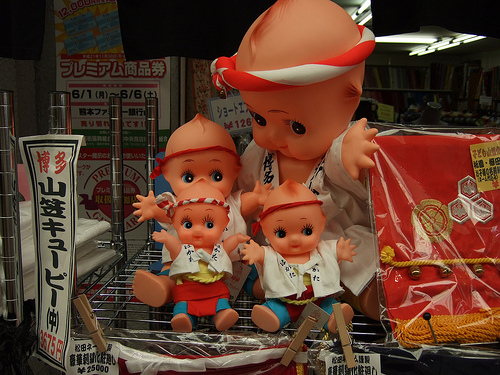
 by pelican
by pelican
Toichiro realized that he could adapt mayonnaise to Japan’s market by increasing the amount of egg yolk in the recipe. Since then, the company has been marketing mayonnaise with the name Kewpie, which originated from the popular doll created by illustrator and artist, Rosie O’Neill.
Unlike other mayonnaise products that usually use whole eggs, Kewpie Mayo is a made from purely egg yolks. This gives the product a smooth, egg flavor that is similar to homemade mayo. However, it contains no sugar. Other ingredients in Kewpie are vegetable oil, vinegar, spices and other seasonings which gives it a sharp and tangy taste. (Learn more on the difference between Japanese Mayo and American Mayo)
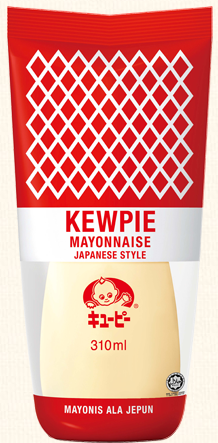

source: kewpie.com
Kewpie offers a Milder version called "Kewpie Mayonnaise Mild Type." This version follows traditional western Mayo where it uses fresh whole eggs. This mild version is excellent for salads and snacks like Takoyaki (octopus).

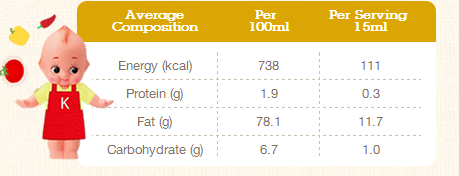
Popularity
Kewpie’s popularity in Japan can’t be overemphasized. Mayo is used on many different food products in Japan and they are many serious competitions that involves this condiment.

People who are known to like the mayonnaise are usually called "mayora" by their friends. Below is a video of Andrew Zimmerman, host of Bizarre Foods who visits a Restaurant specializing in Mayo. It was a strange experience for him but others have enjoyed it and felt it was a fun & tasty adventure!
In this section we have a compilation of blogs pertaining to Japanese Food that we have gathered so far. If your blog is not in the list please email us and we will have it listed.